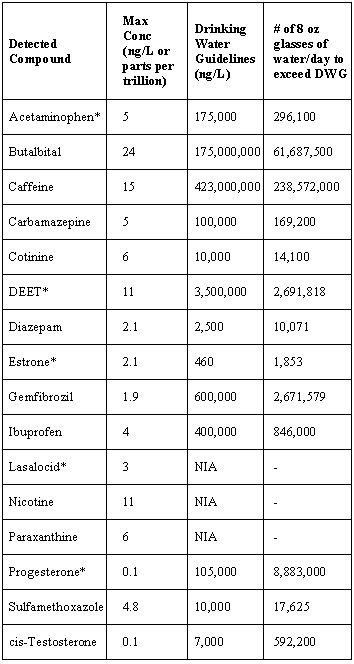FOR IMMEDIATE RELEASE10-55 May 27, 2010 CONTACT: Farrell Sklerov / Michael Saucier (718) 595-6600 DEP Study Shows No Risk from Pharmaceuticals and Personal Care Products in NYC Drinking WaterFindings Confirm NYC Water is Safe and Healthy to DrinkEnvironmental Protection Commissioner Cas Holloway today announced that DEP has concluded a study that indicates that the presence of pharmaceuticals and personal care products in New York City's source waters pose no public health risks. The one-year pilot program tested for the presence of pharmaceuticals and personal care products in New York City's three upstate watersheds, finding only extremely minute quantities of these compounds. The findings confirm that NYC Water remains safe and healthy for the 9 million New Yorkers who rely on it each day. "Our drinking water continues to be the cleanest, healthiest option for quenching New York City's thirst," said Dr. Thomas Farley, NYC Health Commissioner. "DEP's study should reassure anyone concerned about the presence of pharmaceutical or personal-care products in the water supply. The trace amounts documented in this study are far too small to affect people's health. The Health Department and the DEP will continue to work together to periodically monitor concentrations to ensure NYC tap water remains safe." "When I first held a hearing on pharmaceuticals in drinking water in April of 2008, I was impressed at DEP's testimony which outlined the impressive and comprehensive testing program that it was formulating. Now that DEP has tested for various compounds down to the parts-per-trillion level and found nothing remarkable, water consumers can rest assured that the New York City water supply is of the highest quality," said Councilman James F. Gennaro, Chairman of the NYC Council's Committee on Environmental Protection. Throughout 2009, DEP conducted quarterly tests at three source water locations in the Croton, Delaware, and Catskill watersheds to determine whether a target group of pharmaceutical and personal care products could be detected at any level in New York City's water supply. After collection, the samples were tested at two different laboratories in each of the four rounds of sampling during the year. The samples were tested for the presence of 78 compounds — including antibiotics, hormones, prescription medications and endocrine disrupting compounds. Of the 78 compounds tested, 16 pharmaceuticals and personal care products (PPCPs) were detected at least once, and eight compounds were detected in three or more quarters of sampling. None of the 16 detected PPCP compounds were found at a concentration that would present a potential public health concern. In fact, all of the sixteen compounds identified were found in concentrations in the low parts-per-trillion—1,000 times lower than the minimum threshold for any of the target compounds that are regulated by the state or federal government. The fact that a substance is detectable does not mean it is harmful. For example, a person would have to drink 846,000 glasses of water in a single day, approximately 90 years worth of drinking water, to get the dose contained in a single over-the-counter tablet of ibuprofen. Pharmaceuticals have probably been present in water and the environment for as long as humans have been using them. Drugs that are consumed are not entirely absorbed and are excreted and passed into wastewater and surface water. Some pharmaceuticals are easily broken down and processed by the human body or degrade quickly in the environment, but others are not easily broken down and processed, so they enter sewers or septic systems. Externally applied medications and cosmetics can end up in the sewer as well, via showers and baths. Up until recently hospitals and other health care facilities have often flushed out-of-date or excess drugs down toilets. DEP is currently working with the state and our watershed partners to develop alternatives to disposing of unneeded medications that do not pose a threat to the water supply. Wastewater treatment plants are designed to remove solids, chemicals and microorganisms but not at miniscule concentrations. The following 16 pharmaceuticals and personal care products were found in source waters at least once: Acetaminophen, Butalbital, Caffeine, Carbamazepine, cis-Testosterone, Cotinine, DEET, Diazepam, Estrone, Gemfibrozil, Ibuprofen, Lasalocid, Nicotine, Paraxanthine, Progesterone, and Sulfamethoxazole. The amount detected in each, measured in parts per trillion, was significantly lower than what is deemed to be safe by derived drinking water guidelines, a compilation of studies and reports that detail, in general, the maximum amount of a particular substance an individual can be exposed to on a daily basis without causing harmful effects. One part per trillion is equal to one drop of water in 26 Olympic-size swimming pools. The chart below indicates the number of eight-ounce glasses of water per day it takes to reach an acceptable daily intake or get an effect from one of these compounds.
*detected sporadically in less than 50% of samples To prevent pharmaceuticals and personal care products from entering water systems, unused, unneeded, or expired prescription drugs and other medications should be brought to a local pharmaceutical collection event for proper disposal or thrown in the trash by following the instructions and additional information found at www.dontflushyourdrugs.net. DEP manages the City's water supply, providing more than 1 billion gallons of water each day to more than 9 million residents, including 8 million in New York City, and residents of Ulster, Orange, Putnam and Westchester counties. New York City's water is delivered from a watershed that extends more than 125 miles from the City, and comprises 19 reservoirs, and three controlled lakes. Approximately 7,000 miles of water mains, tunnels and aqueducts bring water to homes and businesses throughout the five boroughs, and 7,400 miles of sewer lines take wastewater to 14 in-City treatment plants. Related Links
| ||
